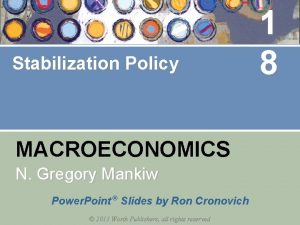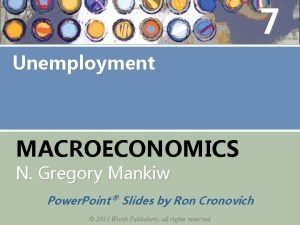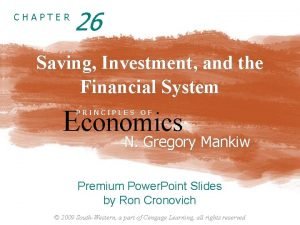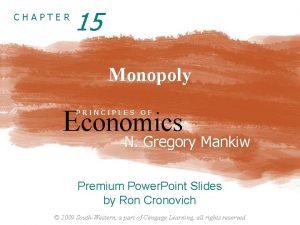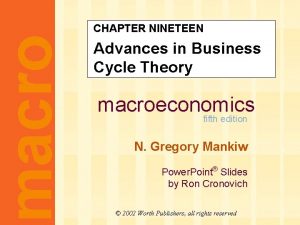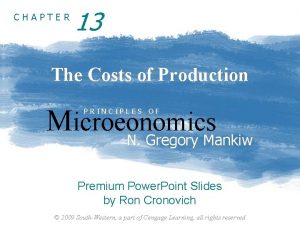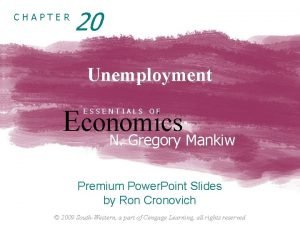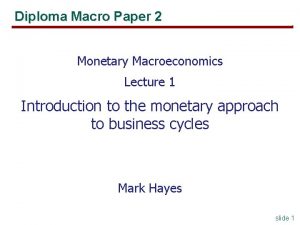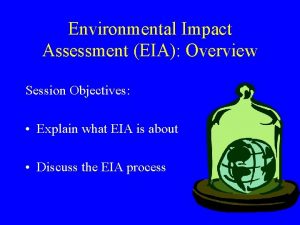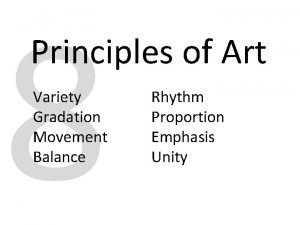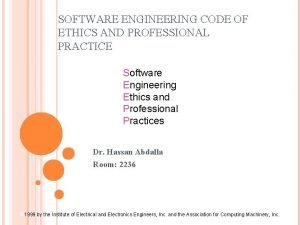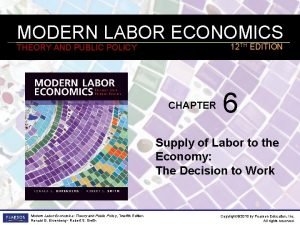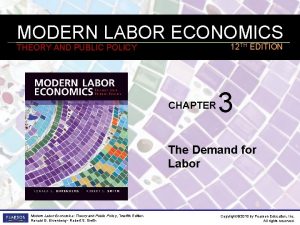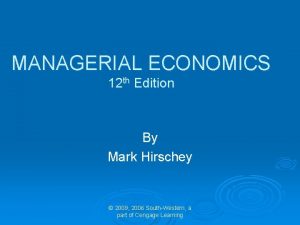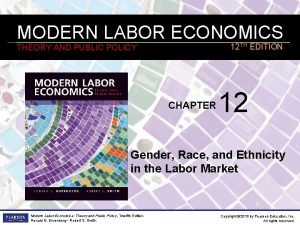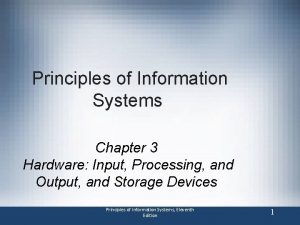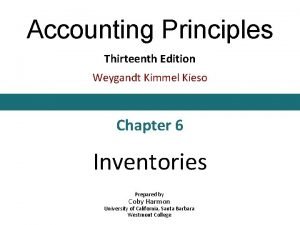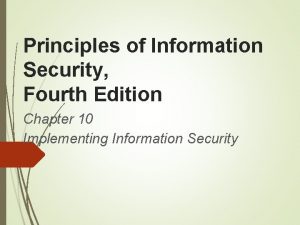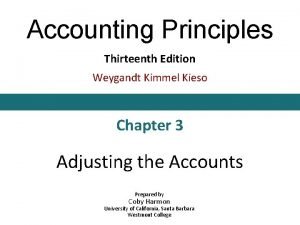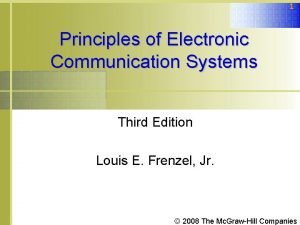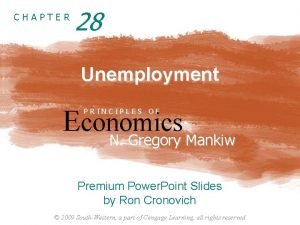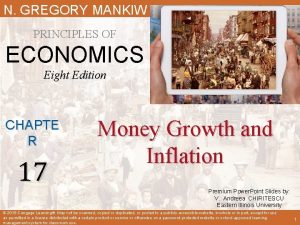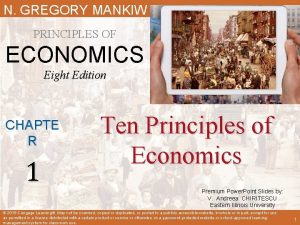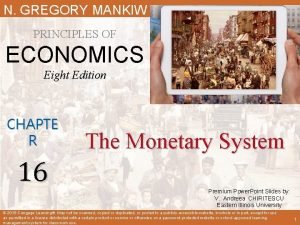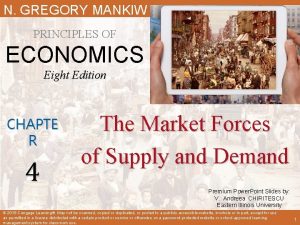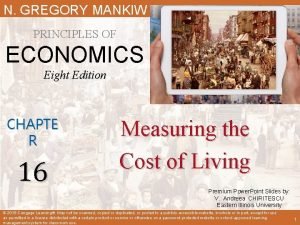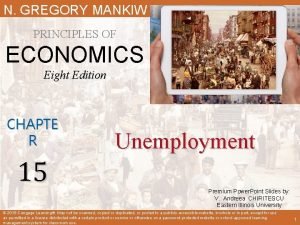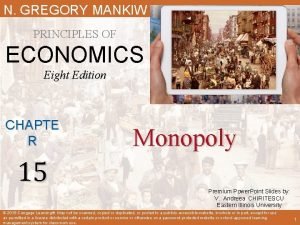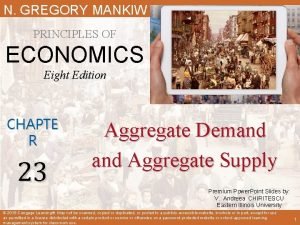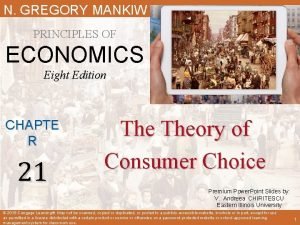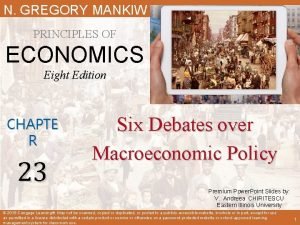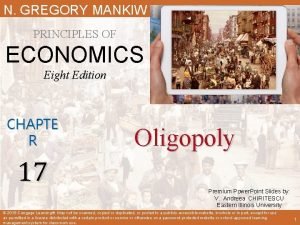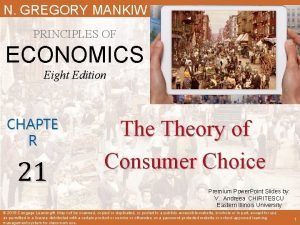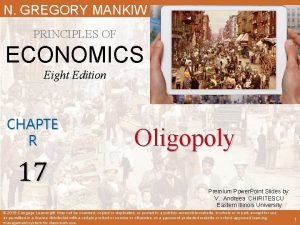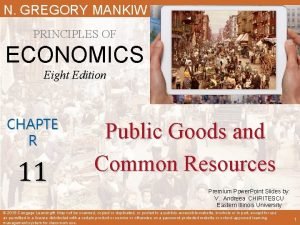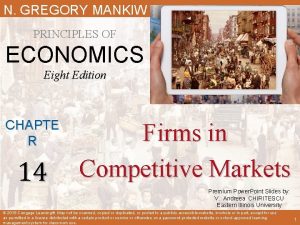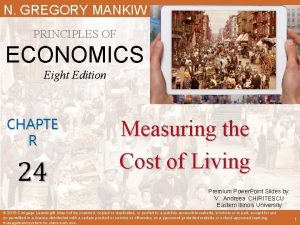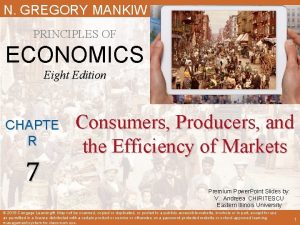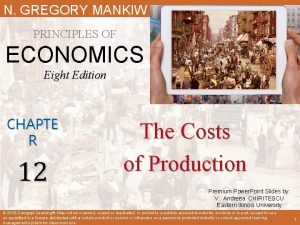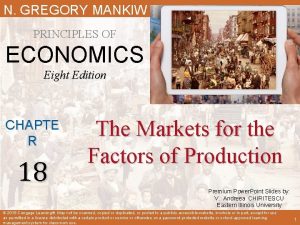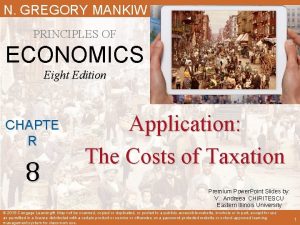N GREGORY MANKIW PRINCIPLES OF ECONOMICS Eight Edition



















































- Slides: 51

N. GREGORY MANKIW PRINCIPLES OF ECONOMICS Eight Edition CHAPTE R 22 Money Growth and Inflation Premium Power. Point Slides by: V. Andreea CHIRITESCU Eastern Illinois University © 2018 Cengage Learning®. May not be scanned, copied or duplicated, or posted to a publicly accessible website, in whole or in part, except for use as permitted in a license distributed with a certain product or service or otherwise on a password-protected website or school-approved learning management system for classroom use. 1

Look for the answers to these questions: • How does the money supply affect inflation and nominal interest rates? • Does the money supply affect real variables like real GDP or the real interest rate? • How is inflation like a tax? • What are the costs of inflation? How serious are they? © 2018 Cengage Learning®. May not be scanned, copied or duplicated, or posted to a publicly accessible website, in whole or in part, except for use as permitted in a license distributed with a certain product or service or otherwise on a password-protected website or school-approved learning management system for classroom use. 2

Introduction • This chapter introduces the quantity theory of money to explain one of the Ten Principles of Economics from Chapter 1: Prices rise when the government prints too much money. – Most economists believe the quantity theory is a good explanation of the long run behavior of inflation. © 2018 Cengage Learning®. May not be scanned, copied or duplicated, or posted to a publicly accessible website, in whole or in part, except for use as permitted in a license distributed with a certain product or service or otherwise on a password-protected website or school-approved learning management system for classroom use. 3

The Value of Money • P = the price level (e. g. , the CPI or GDP deflator) – P is the price of a basket of goods, measured in money. • 1/P is the value of $1, measured in goods. – Example: basket contains one candy bar. • If P = $2, value of $1 is 1/2 candy bar • If P = $3, value of $1 is 1/3 candy bar Inflation drives up prices and drives down the value of money. © 2018 Cengage Learning®. May not be scanned, copied or duplicated, or posted to a publicly accessible website, in whole or in part, except for use as permitted in a license distributed with a certain product or service or otherwise on a password-protected website or school-approved learning management system for classroom use. 4

The Quantity Theory of Money – Developed by 18 th century philosopher David Hume and the classical economists. – Advocated more recently by Nobel Prize Laureate Milton Friedman. – Asserts that the quantity of money determines the value of money – We study this theory using two approaches: 1. A supply-demand diagram 2. An equation © 2018 Cengage Learning®. May not be scanned, copied or duplicated, or posted to a publicly accessible website, in whole or in part, except for use as permitted in a license distributed with a certain product or service or otherwise on a password-protected website or school-approved learning management system for classroom use. 5

Money Supply (MS) • Money supply in the real world – Determined by the Fed, the banking system, and consumers. • Money supply in this model – We assume the Fed precisely controls MS and sets it at some fixed amount. © 2018 Cengage Learning®. May not be scanned, copied or duplicated, or posted to a publicly accessible website, in whole or in part, except for use as permitted in a license distributed with a certain product or service or otherwise on a password-protected website or school-approved learning management system for classroom use. 6

Money Demand (MD) • Money demand – Refers to how much wealth people want to hold in liquid form. – Depends on P: an increase in P reduces the value of money, so more money is required to buy goods and services. • Quantity of money demanded – Is negatively related to the value of money – And positively related to P, other things equal. © 2018 Cengage Learning®. May not be scanned, copied or duplicated, or posted to a publicly accessible website, in whole or in part, except for use as permitted in a license distributed with a certain product or service or otherwise on a password-protected website or school-approved learning management system for classroom use. 7

The Money Supply-Demand Diagram Value of Money, 1/P 1 As the value of money rises, the price level falls. Price Level, P 1 ¾ 1. 33 ½ 2 ¼ 4 Quantity of Money © 2018 Cengage Learning®. May not be scanned, copied or duplicated, or posted to a publicly accessible website, in whole or in part, except for use as permitted in a license distributed with a certain product or service or otherwise on a password-protected website or school-approved learning management system for classroom use. 8

The Money Supply-Demand Diagram Value of Money, 1/P Price Level, P MS 1 1 1 ¾ 1. 33 ½ ¼ The Fed sets MS at some fixed value, regardless of P. $1000 2 4 Quantity of Money © 2018 Cengage Learning®. May not be scanned, copied or duplicated, or posted to a publicly accessible website, in whole or in part, except for use as permitted in a license distributed with a certain product or service or otherwise on a password-protected website or school-approved learning management system for classroom use. 9

The Money Supply-Demand Diagram Value of Money, 1/P 1 A fall in value of money (or increase in P) increases the quantity of money demanded: Price Level, P 1 ¾ 1. 33 ½ 2 ¼ 4 MD 1 Quantity of Money © 2018 Cengage Learning®. May not be scanned, copied or duplicated, or posted to a publicly accessible website, in whole or in part, except for use as permitted in a license distributed with a certain product or service or otherwise on a password-protected website or school-approved learning management system for classroom use. 10

The Money Supply-Demand Diagram Value of Money, 1/P MS 1 1 eq’m value of money P adjusts to equate quantity of money demanded with money supply. 1 1. 33 ¾ ½ Price Level, P A ¼ 2 MD 1 $1000 eq’m price level 4 Quantity of Money © 2018 Cengage Learning®. May not be scanned, copied or duplicated, or posted to a publicly accessible website, in whole or in part, except for use as permitted in a license distributed with a certain product or service or otherwise on a password-protected website or school-approved learning management system for classroom use. 11

The Effects of a Monetary Injection Value of Money, 1/P MS 1 MS 2 1 Fed Suppose the increases the money supply. ¾ eq’m value of money ½ Price Level, P 1 Then the value of money falls, and P rises. 1. 33 A 2 B ¼ MD 1 $1000 4 eq’m price level $2000 Quantity of Money © 2018 Cengage Learning®. May not be scanned, copied or duplicated, or posted to a publicly accessible website, in whole or in part, except for use as permitted in a license distributed with a certain product or service or otherwise on a password-protected website or school-approved learning management system for classroom use. 12

A Brief Look at the Adjustment Process • From graph: Increasing MS causes P to rise. • How does this work? Short version: – At the initial P, an increase in MS causes an excess supply of money. – People get rid of their excess money by spending it on goods and services or by loaning it to others, who spend it. Result: increased demand for goods. – But supply of goods does not increase, so prices must rise. © 2018 Cengage Learning®. May not be scanned, copied or duplicated, or posted to a publicly accessible website, in whole or in part, except for use as permitted in a license distributed with a certain product or service or otherwise on a password-protected website or school-approved learning management system for classroom use. 13

Real vs. Nominal Variables • Nominal variables – Are measured in monetary units. • Examples: nominal GDP, nominal interest rate (rate of return measured in $), nominal wage ($ per hour worked) • Real variables – Are measured in physical units. • Examples: real GDP, real interest rate (measured in output), real wage (measured in output) © 2018 Cengage Learning®. May not be scanned, copied or duplicated, or posted to a publicly accessible website, in whole or in part, except for use as permitted in a license distributed with a certain product or service or otherwise on a password-protected website or school-approved learning management system for classroom use. 14

Real vs. Nominal Variables • Prices are normally measured in terms of money: – Price of a compact disc: – Price of a pepperoni pizza: $15/cd $10/pizza • A relative price – Is the price of one good relative to (divided by) another – Relative price of CDs in terms of pizza: $15/cd price of cd = 1. 5 pizzas per cd = $10/pizza price of pizza © 2018 Cengage Learning®. May not be scanned, copied or duplicated, or posted to a publicly accessible website, in whole or in part, except for use as permitted in a license distributed with a certain product or service or otherwise on a password-protected website or school-approved learning management system for classroom use. 15

Real vs. Nominal Wage • An important relative price is the real wage: – W = nominal wage = price of labor, e. g. , $15/hour – P = price level = price of goods and services, e. g. , $5/unit of output • Real wage – Is the price of labor relative to the price of output: $15/hour W = 3 units output per hour = $5/unit of output P © 2018 Cengage Learning®. May not be scanned, copied or duplicated, or posted to a publicly accessible website, in whole or in part, except for use as permitted in a license distributed with a certain product or service or otherwise on a password-protected website or school-approved learning management system for classroom use. 16

The Classical Dichotomy • Classical dichotomy: – Theoretical separation of nominal and real variables – Hume and the classical economists: monetary developments affect nominal variables but not real variables: • If central bank doubles the money supply: • Then all nominal variables—including prices— will double • But all real variables—including relative prices —will remain unchanged. © 2018 Cengage Learning®. May not be scanned, copied or duplicated, or posted to a publicly accessible website, in whole or in part, except for use as permitted in a license distributed with a certain product or service or otherwise on a password-protected website or school-approved learning management system for classroom use. 17

The Neutrality of Money • Monetary neutrality: – The proposition that changes in the money supply do not affect real variables • Doubling money supply – Causes all nominal prices to double – What happens to relative prices? © 2018 Cengage Learning®. May not be scanned, copied or duplicated, or posted to a publicly accessible website, in whole or in part, except for use as permitted in a license distributed with a certain product or service or otherwise on a password-protected website or school-approved learning management system for classroom use. 18

The Neutrality of Money • Initially, relative price of cd in terms of pizza is $15/cd = 1. 5 pizzas per cd = $10/pizza The relative price • After nominal prices double, is unchanged. $30/cd price of cd = 1. 5 pizzas per cd = $20/pizza price of cd price of pizza © 2018 Cengage Learning®. May not be scanned, copied or duplicated, or posted to a publicly accessible website, in whole or in part, except for use as permitted in a license distributed with a certain product or service or otherwise on a password-protected website or school-approved learning management system for classroom use. 19

The Neutrality of Money • Similarly, the real wage W/P remains unchanged, so – Quantity of labor supplied does not change – Quantity of labor demanded does not change – Total employment of labor does not change • The same applies to employment of capital and other resources. – Since employment of all resources is unchanged, total output is also unchanged by the money supply. © 2018 Cengage Learning®. May not be scanned, copied or duplicated, or posted to a publicly accessible website, in whole or in part, except for use as permitted in a license distributed with a certain product or service or otherwise on a password-protected website or school-approved learning management system for classroom use. 20

The Neutrality of Money • Most economists believe – The classical dichotomy and neutrality of money describe the economy in the long run. • In later chapters – We will see that monetary changes can have important short-run effects on real variables. © 2018 Cengage Learning®. May not be scanned, copied or duplicated, or posted to a publicly accessible website, in whole or in part, except for use as permitted in a license distributed with a certain product or service or otherwise on a password-protected website or school-approved learning management system for classroom use. 21

The Velocity of Money • Velocity of money: – The rate at which money changes hands • Notation: P x Y= nominal GDP = (price level) x (real GDP) M = money supply V = velocity • Velocity formula: Px. Y V = M © 2018 Cengage Learning®. May not be scanned, copied or duplicated, or posted to a publicly accessible website, in whole or in part, except for use as permitted in a license distributed with a certain product or service or otherwise on a password-protected website or school-approved learning management system for classroom use. 22

The Velocity of Money • Velocity formula V = P x Y / M • Example with one good: pizza. In 2015: Y = real GDP = 3000 pizzas P = price level = price of pizza = $10 P x Y= nominal GDP = value of pizzas = $30, 000 M = money supply = $10, 000 V = velocity = $30, 000/$10, 000 = 3 The average dollar was used in 3 transactions. © 2018 Cengage Learning®. May not be scanned, copied or duplicated, or posted to a publicly accessible website, in whole or in part, except for use as permitted in a license distributed with a certain product or service or otherwise on a password-protected website or school-approved learning management system for classroom use. 23

Active Learning 1 Velocity of money One good: corn. The economy has enough labor, capital, and land to produce Y = 800 bushels of corn. V is constant. In 2014, MS = $2000, P = $5/bushel. • Compute nominal GDP and velocity in 2014. Answers • Nominal GDP = P x Y = $5 x 800 = $4000 • velocity V = P x Y / M = $4000 / $2000 = 2 © 2018 Cengage Learning®. May not be scanned, copied or duplicated, or posted to a publicly accessible website, in whole or in part, except for use as permitted in a license distributed with a certain product or service or otherwise on a password-protected website or school-approved learning management system for classroom use. 24

U. S. Nominal GDP, M 2, and Velocity 1960– 2016 Velocity is fairly stable over the long run. 1960=100 Nominal GDP M 2 Velocity © 2018 Cengage Learning®. May not be scanned, copied or duplicated, or posted to a publicly accessible website, in whole or in part, except for use as permitted in a license distributed with a certain product or service or otherwise on a password-protected website or school-approved learning management system for classroom use. 25

The Quantity Theory • The quantity equation: M x V = P x Y 1. 2. 3. 4. 5. V is stable. A change in M causes nominal GDP (P x Y) to change by the same percentage. A change in M does not affect Y: money is neutral, Y is determined by technology & resources So, P changes by same percentage as P x Y and M. Rapid money supply growth causes rapid inflation. © 2018 Cengage Learning®. May not be scanned, copied or duplicated, or posted to a publicly accessible website, in whole or in part, except for use as permitted in a license distributed with a certain product or service or otherwise on a password-protected website or school-approved learning management system for classroom use. 26

Active Learning 2 Quantity Theory of Money One good: corn. The economy has enough labor, capital, and land to produce Y = 800 bushels of corn. V is constant. In 2014, MS = $2000, P = $5/bushel. For 2015, the Fed increases MS by 5%, to $2100. a. Compute the 2015 values of nominal GDP and P. Compute the inflation rate for 2014– 2015. b. Suppose tech. progress causes Y to increase to 824 in 2015. Compute 2014– 2015 inflation rate. © 2018 Cengage Learning®. May not be scanned, copied or duplicated, or posted to a publicly accessible website, in whole or in part, except for use as permitted in a license distributed with a certain product or service or otherwise on a password-protected website or school-approved learning management system for classroom use. 27

Active Learning 2 Answers Y = 800, V is constant. In 2014, MS = $2000, P = $5/bushel. For 2015, the Fed increases MS by 5%, to $2100. a. Compute the 2015 values of nominal GDP and P. Compute the inflation rate for 2014– 2015. – 2014: P x Y = M x V, so V= 2 – 2015: nominal GDP = P x Y = M x V = 2100 x 2 = $4200 – 2015: P = M x V / Y = 4200/800 = $5. 25 – Inflation rate 2014 -2015 = (5. 25 – 5. 00)/5. 00 = 5% (same as MS!) © 2018 Cengage Learning®. May not be scanned, copied or duplicated, or posted to a publicly accessible website, in whole or in part, except for use as permitted in a license distributed with a certain product or service or otherwise on a password-protected website or school-approved learning management system for classroom use. 28

Active Learning 2 Answers Y = 800, V is constant. In 2014, MS = $2000, P = $5/bushel. For 2015, the Fed increases MS by 5%, to $2100. b. Suppose tech. progress causes Y to increase to 824 in 2015. Compute 2014– 2015 inflation rate. – 2015: P = M x V / Y = 4200/824 = $5. 10 – Inflation rate 2014 -2015 = (5. 10 – 5. 00)/5. 00 = 2% © 2018 Cengage Learning®. May not be scanned, copied or duplicated, or posted to a publicly accessible website, in whole or in part, except for use as permitted in a license distributed with a certain product or service or otherwise on a password-protected website or school-approved learning management system for classroom use. 29

Lessons about the quantity theory of money • If real GDP is constant, – Then inflation rate = money growth rate. • If real GDP is growing, – Then inflation rate < money growth rate. • The bottom line: – Economic growth increases # of transactions. – Some money growth is needed for these extra transactions. – Excessive money growth causes inflation. © 2018 Cengage Learning®. May not be scanned, copied or duplicated, or posted to a publicly accessible website, in whole or in part, except for use as permitted in a license distributed with a certain product or service or otherwise on a password-protected website or school-approved learning management system for classroom use. 30

Hyperinflation • Hyperinflation – Inflation exceeding 50% per month. • Prices rise when the government prints too much money. – Excessive growth in the money supply always causes hyperinflation. © 2018 Cengage Learning®. May not be scanned, copied or duplicated, or posted to a publicly accessible website, in whole or in part, except for use as permitted in a license distributed with a certain product or service or otherwise on a password-protected website or school-approved learning management system for classroom use. 31

Hyperinflation in Zimbabwe • Large government budget deficits – Led to the creation of large quantities of money and high inflation rates. date Sign posted in public restroom Zim$ per US$ Aug 2007 245 Apr 2008 29, 401 May 2008 207, 209, 688 June 2008 4, 470, 828, 401 July 2008 26, 421, 447, 043 Feb 2009 37, 410, 030 Sept 2009 355 © 2018 Cengage Learning®. May not be scanned, copied or duplicated, or posted to a publicly accessible website, in whole or in part, except for use as permitted in a license distributed with a certain product or service or otherwise on a password-protected website or school-approved learning management system for classroom use. 32

The Inflation Tax • The inflation tax – Revenue the government raises by creating (printing) money – Like a tax on everyone who holds money • When the government prints money • The price level rises • And the dollars in your wallet are less valuable – In the U. S. , the inflation tax today accounts for less than 3% of total revenue © 2018 Cengage Learning®. May not be scanned, copied or duplicated, or posted to a publicly accessible website, in whole or in part, except for use as permitted in a license distributed with a certain product or service or otherwise on a password-protected website or school-approved learning management system for classroom use. 33

The Fisher Effect • Principle of monetary neutrality – An increase in the rate of money growth raises the rate of inflation but does not affect any real variable • Because Real interest rate = Nominal interest rate – Inflation rate • We get Nominal interest rate = Real interest rate + Inflation rate © 2018 Cengage Learning®. May not be scanned, copied or duplicated, or posted to a publicly accessible website, in whole or in part, except for use as permitted in a license distributed with a certain product or service or otherwise on a password-protected website or school-approved learning management system for classroom use. 34

The Fisher Effect • Fisher effect – One-for-one adjustment of nominal interest rate to inflation rate – When the Fed increases the rate of money growth – Long-run result • Higher inflation rate • Higher nominal interest rate © 2018 Cengage Learning®. May not be scanned, copied or duplicated, or posted to a publicly accessible website, in whole or in part, except for use as permitted in a license distributed with a certain product or service or otherwise on a password-protected website or school-approved learning management system for classroom use. 35

U. S. Nominal Interest & Inflation Rates, 1960– 2016 The close relation between these variables is evidence for the Fisher effect. Nominal interest rate Inflation rate © 2018 Cengage Learning®. May not be scanned, copied or duplicated, or posted to a publicly accessible website, in whole or in part, except for use as permitted in a license distributed with a certain product or service or otherwise on a password-protected website or school-approved learning management system for classroom use. 36

The Costs of Inflation • Inflation fallacy – “Inflation robs people of the purchasing power of his hard-earned dollars” • When prices rise – Buyers pay more – Sellers get more • Inflation does not in itself reduce people’s real purchasing power © 2018 Cengage Learning®. May not be scanned, copied or duplicated, or posted to a publicly accessible website, in whole or in part, except for use as permitted in a license distributed with a certain product or service or otherwise on a password-protected website or school-approved learning management system for classroom use. 37

U. S. Average Hourly Earnings & the CPI 1965 - 2016 Inflation causes the CPI and nominal wages to rise together over the long run. Nominal wage CPI © 2018 Cengage Learning®. May not be scanned, copied or duplicated, or posted to a publicly accessible website, in whole or in part, except for use as permitted in a license distributed with a certain product or service or otherwise on a password-protected website or school-approved learning management system for classroom use. 38

The Costs of Inflation • Shoeleather costs – Resources wasted when inflation encourages people to reduce their money holdings – Can be substantial • Menu costs – Costs of changing prices – Inflation – increases menu costs that firms must bear © 2018 Cengage Learning®. May not be scanned, copied or duplicated, or posted to a publicly accessible website, in whole or in part, except for use as permitted in a license distributed with a certain product or service or otherwise on a password-protected website or school-approved learning management system for classroom use. 39

The Costs of Inflation • Misallocation of resources from relativeprice variability: – Firms don’t all raise prices at the same time, so relative prices can vary • Distorts the allocation of resources • Confusion and inconvenience: – Inflation changes the yardstick we use to measure transactions • Complicates long-range planning and the comparison of dollar amounts over time © 2018 Cengage Learning®. May not be scanned, copied or duplicated, or posted to a publicly accessible website, in whole or in part, except for use as permitted in a license distributed with a certain product or service or otherwise on a password-protected website or school-approved learning management system for classroom use. 40

The Costs of Inflation • Tax distortions: – Inflation makes nominal income grow faster than real income. – Taxes are based on nominal income, and some are not adjusted for inflation. – So, inflation causes people to pay more taxes even when their real incomes don’t increase. © 2018 Cengage Learning®. May not be scanned, copied or duplicated, or posted to a publicly accessible website, in whole or in part, except for use as permitted in a license distributed with a certain product or service or otherwise on a password-protected website or school-approved learning management system for classroom use. 41

Active Learning 3 Tax distortions You deposit $1000 in the bank for one year. CASE 1: inflation = 0%, nom. interest rate = 10% CASE 2: inflation = 10%, nom. interest rate = 20% a. In which case does the real value of your deposit grow the most? Assume the tax rate is 25%. b. In which case do you pay the most taxes? c. Compute the after-tax nominal interest rate, then subtract inflation to get the after-tax real interest rate for both cases. © 2018 Cengage Learning®. May not be scanned, copied or duplicated, or posted to a publicly accessible website, in whole or in part, except for use as permitted in a license distributed with a certain product or service or otherwise on a password-protected website or school-approved learning management system for classroom use. 42

Active Learning 3 Answers Deposit $1000. CASE 1: inflation = 0%, nom. interest rate = 10% CASE 2: inflation = 10%, nom. interest rate = 20% a. In which case does the real value of your deposit grow the most? In both cases, the real interest rate is 10%, so the real value of the deposit grows 10% (before taxes). © 2018 Cengage Learning®. May not be scanned, copied or duplicated, or posted to a publicly accessible website, in whole or in part, except for use as permitted in a license distributed with a certain product or service or otherwise on a password-protected website or school-approved learning management system for classroom use. 43

Active Learning 3 Answers Deposit $1000. Tax rate =25%. CASE 1: inflation = 0%, nom. interest rate = 10% CASE 2: inflation = 10%, nom. interest rate = 20% b. In which case do you pay the most taxes? CASE 1: interest income = $100, so you pay $25 in taxes. CASE 2: interest income = $200, so you pay $50 in taxes. © 2018 Cengage Learning®. May not be scanned, copied or duplicated, or posted to a publicly accessible website, in whole or in part, except for use as permitted in a license distributed with a certain product or service or otherwise on a password-protected website or school-approved learning management system for classroom use. 44

Active Learning 3 Answers Deposit $1000. Tax rate =25%. CASE 1: inflation = 0%, nom. interest rate = 10% CASE 2: inflation = 10%, nom. interest rate = 20% c. Compute the after-tax nominal interest rate, then subtract inflation to get the after-tax real interest rate for both cases. CASE 1: nominal = 0. 75 x 10% = 7. 5% real = 7. 5% – 0% = 7. 5% CASE 2: nominal = 0. 75 x 20% = 15% real =15% – 10% = 5% © 2018 Cengage Learning®. May not be scanned, copied or duplicated, or posted to a publicly accessible website, in whole or in part, except for use as permitted in a license distributed with a certain product or service or otherwise on a password-protected website or school-approved learning management system for classroom use. 45

Active Learning 3 Summary and lessons Deposit $1000. Tax rate =25%. CASE 1: inflation = 0%, nom. interest rate = 10% CASE 2: inflation = 10%, nom. interest rate = 20% Inflation… • raises nominal interest rates (Fisher effect) but not real interest rates • increases savers’ tax burdens • lowers the after-tax real interest rate © 2018 Cengage Learning®. May not be scanned, copied or duplicated, or posted to a publicly accessible website, in whole or in part, except for use as permitted in a license distributed with a certain product or service or otherwise on a password-protected website or school-approved learning management system for classroom use. 46

Arbitrary Redistributions of Wealth • Unexpected inflation – Redistributes wealth among the population • Not by merit • Not by need – Redistribute wealth among debtors and creditors • Inflation: volatile and uncertain – When the average rate of inflation is high © 2018 Cengage Learning®. May not be scanned, copied or duplicated, or posted to a publicly accessible website, in whole or in part, except for use as permitted in a license distributed with a certain product or service or otherwise on a password-protected website or school-approved learning management system for classroom use. 47

The Costs of Inflation • All these costs – Are quite high for economies experiencing hyperinflation. • For economies with low inflation (< 10% per year), – These costs are probably much smaller, though their exact size is open to debate. © 2018 Cengage Learning®. May not be scanned, copied or duplicated, or posted to a publicly accessible website, in whole or in part, except for use as permitted in a license distributed with a certain product or service or otherwise on a password-protected website or school-approved learning management system for classroom use. 48

Conclusion Prices rise when the government prints too much money. – We saw that money is neutral in the long run, affecting only nominal variables • In later chapters – Money has important effects in the short run on real variables like output and employment © 2018 Cengage Learning®. May not be scanned, copied or duplicated, or posted to a publicly accessible website, in whole or in part, except for use as permitted in a license distributed with a certain product or service or otherwise on a password-protected website or school-approved learning management system for classroom use. 49

Summary • To explain inflation in the long run, economists use the quantity theory of money. • The price level depends on the quantity of money, and the inflation rate depends on the money growth rate. • The classical dichotomy is the division of variables into real and nominal. The neutrality of money is the idea that changes in the money supply affect nominal variables but not real ones. Most economists believe these ideas describe the economy in the long run. © 2018 Cengage Learning®. May not be scanned, copied or duplicated, or posted to a publicly accessible website, in whole or in part, except for use as permitted in a license distributed with a certain product or service or otherwise on a password-protected website or school-approved learning management system for classroom use. 50

Summary • The inflation tax is the loss in the real value of • • people’s money holdings when the government causes inflation by printing money. The Fisher effect is the one-for-one relation between changes in the inflation rate and changes in the nominal interest rate. The costs of inflation include menu costs, shoeleather costs, confusion and inconvenience, distortions in relative prices and the allocation of resources, tax distortions, and arbitrary redistributions of wealth. © 2018 Cengage Learning®. May not be scanned, copied or duplicated, or posted to a publicly accessible website, in whole or in part, except for use as permitted in a license distributed with a certain product or service or otherwise on a password-protected website or school-approved learning management system for classroom use. 51
 Principles of economics mankiw 9th edition ppt
Principles of economics mankiw 9th edition ppt Principles of economics mankiw 9th edition ppt
Principles of economics mankiw 9th edition ppt Mankiw macroeconomics 9th edition
Mankiw macroeconomics 9th edition Principle of economics oxford
Principle of economics oxford Principles of economics sixth edition
Principles of economics sixth edition Plane shapes
Plane shapes What are the meanings of the eight shapes and eight colors
What are the meanings of the eight shapes and eight colors Mankiw chapter 26 solutions
Mankiw chapter 26 solutions Chapter 15 monopoly
Chapter 15 monopoly Site:slidetodoc.com
Site:slidetodoc.com The costs of production chapter 13
The costs of production chapter 13 Intermediate macroeconomics mankiw
Intermediate macroeconomics mankiw Mankiw slides
Mankiw slides Mankiw
Mankiw Evolution of eia
Evolution of eia Gradation in art definition
Gradation in art definition Code of ethics for software engineers
Code of ethics for software engineers Mis chapter 6
Mis chapter 6 Using mis 10th edition
Using mis 10th edition Modern labor economics 12th edition solution
Modern labor economics 12th edition solution Modern labor economics 12th edition
Modern labor economics 12th edition Microeconomics michael parkin 13th edition
Microeconomics michael parkin 13th edition Managerial economics 12th edition mark hirschey
Managerial economics 12th edition mark hirschey Parkin economics 12th edition
Parkin economics 12th edition Modern labor economics 12th edition
Modern labor economics 12th edition Maastricht university economics and business economics
Maastricht university economics and business economics Non mathematical economics
Non mathematical economics Principles of information security 5th edition pdf
Principles of information security 5th edition pdf Principles of electronic communication systems 3rd edition
Principles of electronic communication systems 3rd edition Computer security principles and practice 4th edition
Computer security principles and practice 4th edition Accounting principles second canadian edition
Accounting principles second canadian edition Accounting principles second canadian edition
Accounting principles second canadian edition Accounting principles second canadian edition
Accounting principles second canadian edition Principles of management (collection) stephen p. robbins
Principles of management (collection) stephen p. robbins Involuntary inactive real estate license florida
Involuntary inactive real estate license florida Information management principles
Information management principles Principles of information systems 11th edition
Principles of information systems 11th edition Information asset classification worksheet
Information asset classification worksheet Principles of marketing fifth european edition
Principles of marketing fifth european edition Beginning inventory formula
Beginning inventory formula Accounting principles second canadian edition
Accounting principles second canadian edition 12 principles of information security
12 principles of information security Information security
Information security Marketing management (arab world edition) philip kotler
Marketing management (arab world edition) philip kotler Florida real estate principles practices & law 43rd edition
Florida real estate principles practices & law 43rd edition Computer security principles and practice 4th edition
Computer security principles and practice 4th edition Principles of electric circuits 10th edition answer key
Principles of electric circuits 10th edition answer key Accounting principles 13th edition
Accounting principles 13th edition Principles of electronic communication systems 3rd edition
Principles of electronic communication systems 3rd edition Chapter 2 principles of marketing
Chapter 2 principles of marketing Expert systems: principles and programming, fourth edition
Expert systems: principles and programming, fourth edition Chapter 28 unemployment problems and applications answers
Chapter 28 unemployment problems and applications answers
